This post may contain affiliate links, from which we earn an income. Click here to read our affiliate policy.
The Transfagarasan is a spectacular twisting road through the Carpathian Mountains in Romania, and thanks to Top Gear, is one of Romania’s most popular destinations.
This spectacular mountain pass, Romania’s second highest paved mountain route, is a real treat for drivers as it passes dramatic forested mountains, alpine lakes, and historic castles, connecting north with south. It’s no surprise that Jeremy Clarkson pronounced it “the best road in the world”.
The Transfagarasaan is a road to be savored and in this Transfagarasan guide we share literally everything you need to know including getting there, the iconic sights, places to stay, and things to do along the route, taking in the best that this part of Romania has to offer.
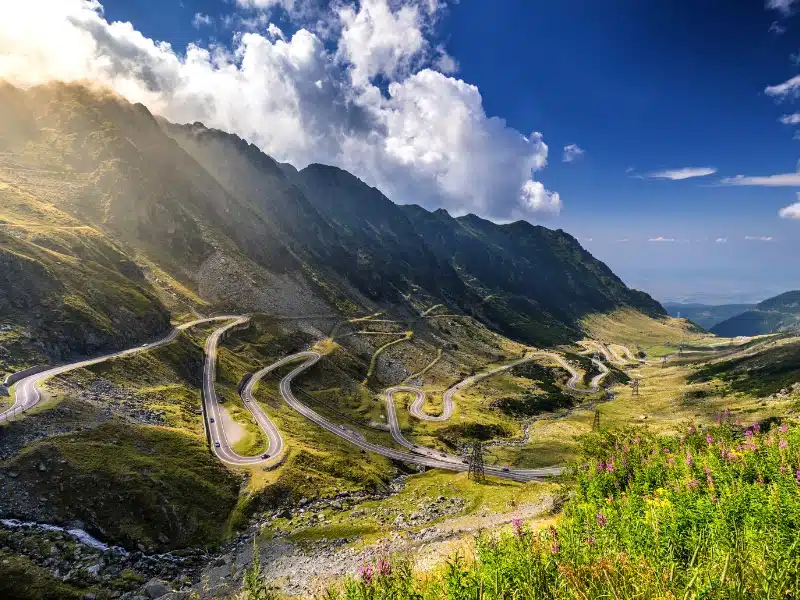
What is the Transfagarasan Road in Romania?
The Transfăgărășan (Trans•fagara•shan) or DN7C is a national-level paved mountain road crossing the southern section of the Carpathian Mountains of Romania. The name Trans Fagarasan means across Fagaras or Fagaras crossing, after the Făgăraș Mountains which the road traverses.
Built in the early 1970s as a strategic military route by Nicolae Ceausescu’s communist regime, this Romanian highway connects the historic regions of Transylvania and Wallachia and is the second highest mountain pass in the country after the Transalpina.
It is thought that the former communist dictator wanted to ensure quick military access across the Fagaras Mountains, also known as the Transylvanian Alps, to send Romanian Army troops north in case Romania got invaded by the Soviet Union. At the time, Romania already had several strategic mountain passes including the DN67C Transalpina but they were through river valleys and would be easy for the Soviets to block and attack.
Built mainly by military personnel, the road took a high human and financial toll. Untrained military personnel working in an alpine climate at an elevation of 6,600 feet / 2,000 meters and using dynamite led to hundreds of troops losing their lives, although the official records state that only 40 soldiers died.
Starting near the village of Bascov, near Pitești, the Transfagarasan Highway stretches for 94 miles / 151 kilometers to the crossroad between the DN1 and Sibiu. The route twists and turns between Moldoveanu and Negoiu, the highest peaks in the country, and tops out at 6,699 feet / 2,042 meters above sea level at the Pasul Bâlea, the longest road tunnel in Romania.
The Transfagarasan boasts 80 hairpin bends and switchbacks, five tunnels, over 500 small bridges, and many long S-turns and is popular with road trippers, drivers, and motorcycling enthusiasts due to its stunning views and challenging twists and turns. The road became even more popular when the Top Gear team featured it in the 14th season premiere in 2009.
RELATED POST: Why We Think These Are The Best Driving Roads in Europe
Make sure you have travel insurance you can trust when visiting Romania. We recommend True Traveller for their 5-star TrustPilot reviews, variety of cover options, best activities cover as standard, great prices, and excellent service.
Getting There
Fly into Bucharest’s Henri Coandă International Airport in Otopeni to start your Transfagarasan adventure, just a two hour drive from the start point in Bascov. With direct flights from Europe, the Middle East, and the UK, we recommend booking through Skyscanner for live deals and the best prices.
Why not take your own car, motorbike, or camper to the Tranfagarasan Road and enjoy a Romanian road trip? Romania is easily accessible from Western and Northern Europe via Hungary, from the Balkans through Serbia, and from Greece and Turkey from Bulgaria.
Don’t forget your road trip essentials! Our free road trip checklists help you remember everything, including road trip snacks, podcasts, and road trip songs for the journey!
How to Travel the Transfagarasan Romania
Self-Drive
Whether you’re in a car, motorcycle, campervan, or motorhome, self-driving is absolutely the best way to explore Romania’s Transfagarasan Road, meaning you can stop whenever you want, try new activities, visit places you see along the route, and have the freedom to change plans at the last minute.
Are you planning to rent a car in Romania? As one of the largest car hire aggregator companies in the world, we recommend Rentalcars.com because they have massive purchasing power which enables them to secure the best rental car prices, which benefits you when you’re planning your Transfagarasan drive.
For a real adventure, hire a motorhome or campervan in Romania. We recommend Motorhome Republic, an aggregate booking site who pull together all the best deals from a number of rental agencies, to offer you a wide choice of options alongside an excellent English speaking expert motorhome Concierge Team. Use the Park4Night app to find overnight spots and campsites along the highway.
Transfagarasan Road Tours
There is no public transport along the Transfagarasan Road, but there are one day trips and multi-day tours from Bucharest which means that you can explore this picturesque part of Romania without your own transport, and enjoy hearing interesting facts and anecdotes about the road from your tour guide. These are our top picks of highly-rated and recommended Transfagarasan Road tours.
Transfagarasan Highway Map & Route
- Brandt Travel Guides Transylvania
- Romania Culture Smart! The Essential Guide to Customs & Culture
- The Rough Guide to Romania
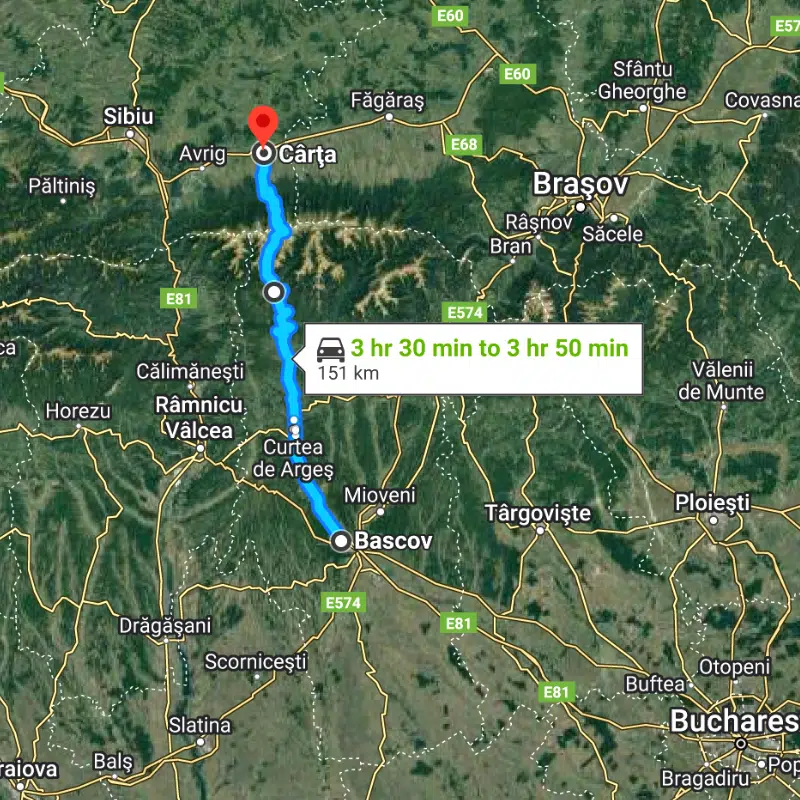
Transfagarasan Road Itinerary
Piteşti
Just over 70 miles from Bucharest is Piteşti, known for its historic buildings, cafés, and retail shops.
There’s not a huge amount to see in Piteşti, but as you’re passing through you should definitely visit the Piteşti Prison Memorial. This prison was where political prisoners including intellectuals and members of the ruling class were tortured and executed by the communist regime between 1948-1954.
Curtea de Argeş
24 miles / 38km north of Piteşti is Curtea de Argeş, more interesting than the other southern route to the Transfagarasan, Râmnicu Vâlcea. Curtea de Argeş is home to the mostly ruined Curtea Domneasca or Royal Court built by Basarab I of Wallachia in the 14th century, and his final resting place is near the Royal Church altar.
The Byzantine Royal Church was entirely renovated in the early 2000s and is now open to the public, whereas much of the remaining Royal Court, sometimes called the Princely Court, is in ruins.
Further north in the town is the Curtea Biserica Episcopala Curtea de Arges, a Romanian Orthodox cathedral built by Neagoe Basarab, the son of Basarab I, in the early 1500s and faced with limestone from Constantinople.
In the village of Albestii de Arges, just north of Curtea de Argeş, the DN7C becomes the Transfagarasen Road.
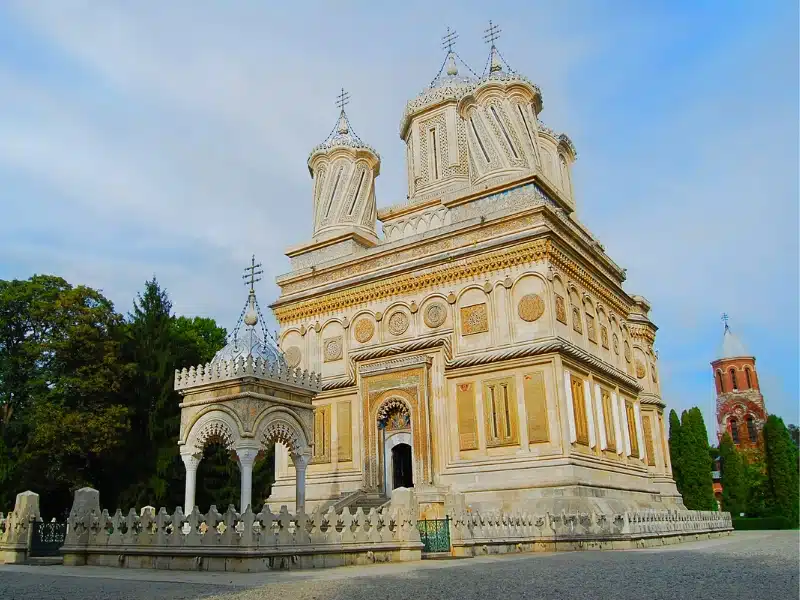
Capatenii Pamantului
From this point, the southern half of the road climbs steadily to the last village, Capatenii Pamantului, which means ‘ends of the earth’ in Romanian… gulp! As well as this augur of doom, the village is also home to the ruins of Cetatea Poienari or Poienari Castle, one time residence of Vlad the Impaler.
Vlad III, commonly known as Vlad the Impaler or Vlad Dracula, was Voivode or Prince of Wallachia three times between 1448 and his death in 1476 or 1477, and inspired the name of Bram Stoker’s literary vampire, Count Dracula, making Poienari Castle the original Dracula Castle, not Bran Castle as many people think.
You can spot the dramatic Poienari Castle high on a forested slope on the left of the road. It is possible to visit the citadel if you’re happy to hike up 1480 punishingly steep steps – you need a head for heights and a lot of stamina for this castle!
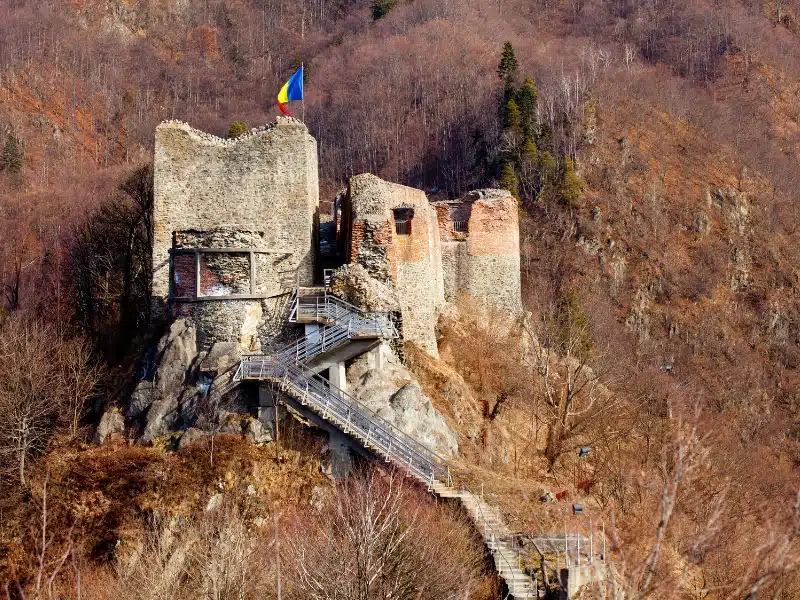
Vidraru Dam
From Poienari Castle the road includes a few hairpins and three short tunnels before you arrive at the next highlight of the Transfagarasan, the Vidraru Dam.
The arch dam, completed in 1966, was built to produce hydroelectricity and is the 16th tallest dam in Europe at 545 feet / 166 meters. The arch length, which you actually drive over, is 305 meters, and the dam itself can store 465 million cubic meters of water.
The drive over the dam is spectacular, with incredible views north of Lake Vidraru and the Frunţii and Ghiţu Mountains. As you come off the dam look to your right for the bronze statue of Prometheus, the Titan god of fire in Greek mythology.
The statue, sometimes called the Electricity Monument, depicts an iron man holding a lightning bolt to represent electricity and commemorates one of the Communist Bloc’s biggest hydroelectricity achievements. Park where you can and walk up the few hundred steps to the 33 foot / 10 meter tall statue, for even more incredible views.
Just along the shore from the statue boat trips depart for a spin on the lake. Departure times can be a bit ad hoc but during July and August, boats depart regularly.
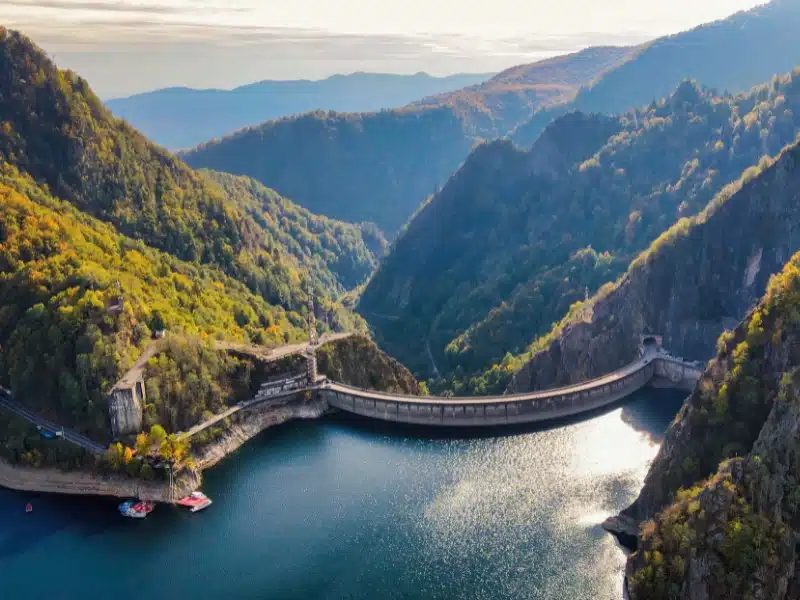
Pasul Bâlea
The Transfagarasan then follows the contours of the lake with the turquoise water often visible through the trees before leaving the valley to climb steeply along the east face of the Făgărăş Mountains to pass several highlights, including the Goat Waterfall or Capra Cascada and several a small roadside shrines.
As you arrive at the highest point at 2,042 meters you’ll enter the unlit 890m Bâlea Tunnel, the longest tunnel in Romania. As you emerge on the northern side of the Transfagarasen Road, you’ll get that iconic view of the road snaking down the valley, which makes it one of the best driving roads in Europe.
Coming out of the tunnel you’ll see food stands and stalls selling local cheeses, sausage, and other traditional Romanian foods including kurtos kalac or chimney cake. This popular Hungarian sweet treat is made by wrapping buttery pastry around a cylinder, coating it with sugar, and baking in an open fire …yum!
It was this view that Jeremy Clarkson, in his Aston Martin DBS Volante (Richard Hammond was in a Ferrari California and James May drove a Lamborghini Gallardo LP560-4 Spyder), described as “every great corner from every great race track lined up one after the other”.
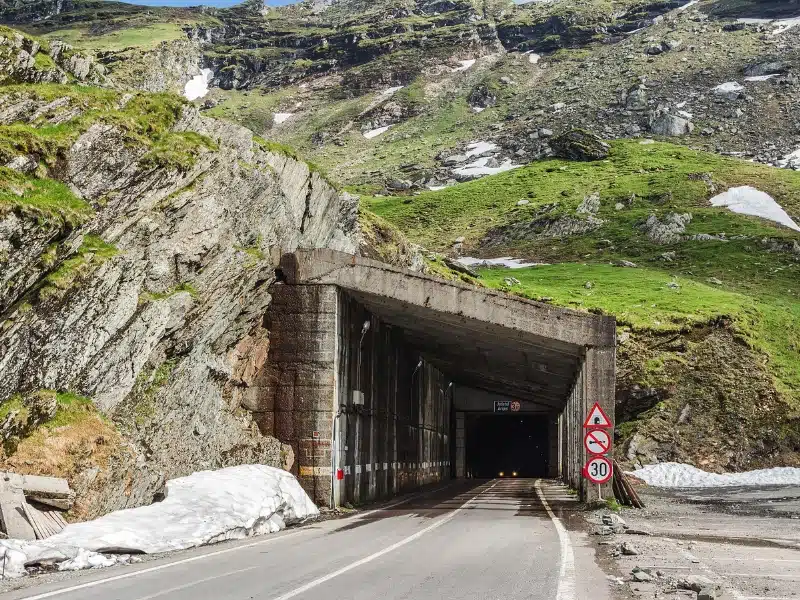
Lacul Bâlea
Bâlea Lake is a glacial lake located at an altitude of 6,673 feet / 2,034km that offers stunning views and opportunities for hiking and boating in the summer months. The Bâlea Waterfall, located nearby, is also a popular stop, with its impressive cascades.
On your right, a little way after you come out of the tunnel, is the Bâlea Lac Telecabină, the cable car which provides access to the Ice Hotel in winter and a couple of cabanas which also have good restaurants. You can stop by the road here to take photos of the lake and the view north.
The Făgărăş Mountains are home to some fantastic well-signed hiking trails which cross the mountains, and there are mountain refuge huts nearby that offer basic food and accommodation. You can pick up several hiking trails at Lac Bâlea, including the path to Negoiu Peak, which is the highest mountain in the range and the second highest in Romania at 2,535 meters above sea level.
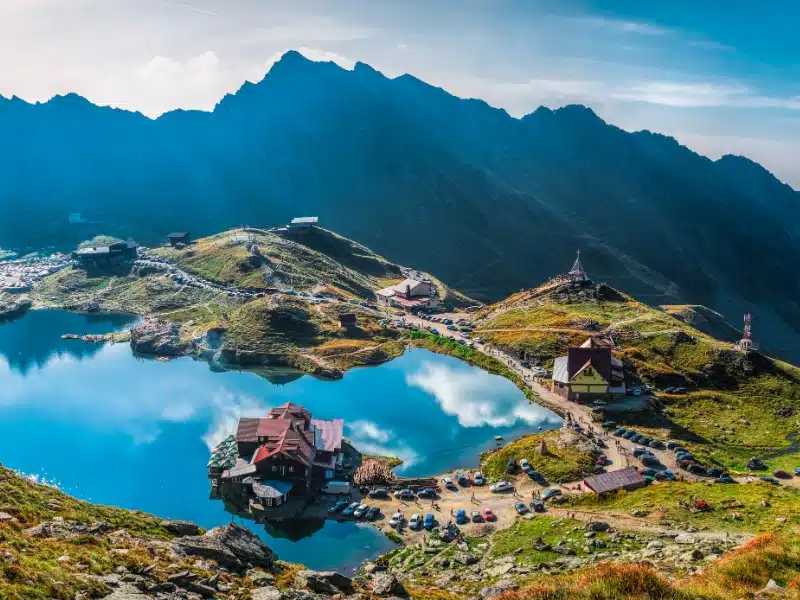
Cartisoara
From Bâlea Lac the 25km drive down the most twisty-bendy part of the Transfagarasan to Cartisoara takes around 45 minutes, although during July and August, it can take twice as long due to the amount of traffic on the road.
There are few places on this stretch to stop and take photos and it can feel a little pressured when you have a line of cars behind you, so avoid the weekends if possible, when the road is at its busiest.
There are a few small memorials along the route to those who died building the road, such as Lazar’s Rock, Zavate’s Curve, Dodu’s Stone Tables, and Carmen’s Fountain. At the Poarta Genistilor or Gate of Engineers (very rough translation), just north of the Cascada Bâlea is a commemorative plaque.
The plaque reads “Facing great difficulties, the genius troops of the Romanian Army opened the Transfăgărășan road, breaking through this area in March 1971. In memory of the event, the brave Engineers, who proved to be stronger than the rock, named this place – the Gate of the Genists“
A bit further on is a cable car that runs back up to Bâlea Lac and is the only way up when the road beyond this point (heading south) is closed during the winter, and makes for a pleasant adventure during the summer months.
At Cartisoara itself you can visit the Badea Cârțan Ethnographic Museum to see their collection of painted glass icons and an old shepherd’s house complete with thatched roof.
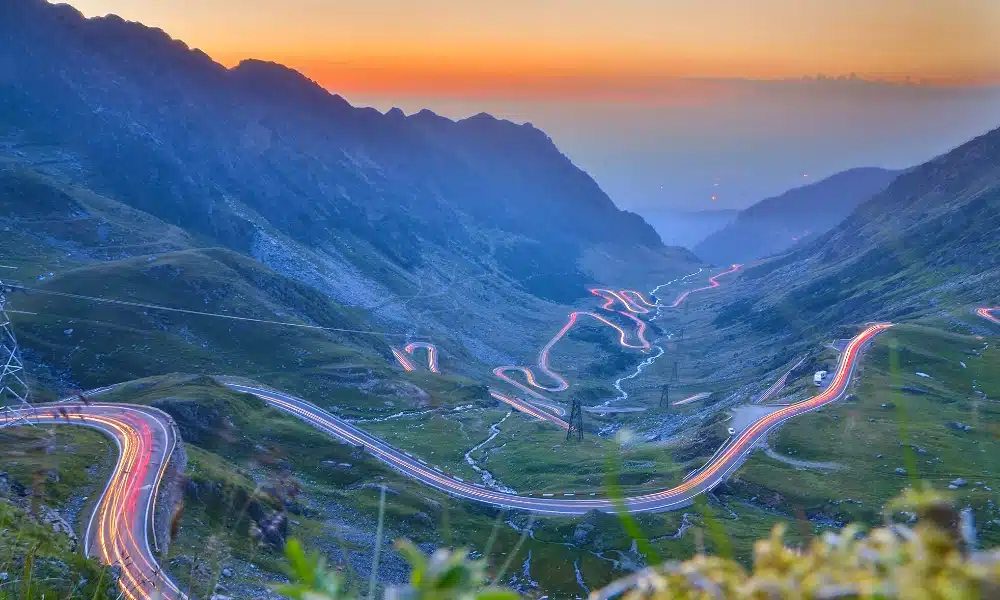
Nearby Road Trips
Transfagarasan Road FAQs
When is the best time to drive the Transfagarasan Road?
Although sections of the road are open year-round, the whole of the Transfagarasan Road is only open fully between June and October.
The Transfagarasan Highway opening times vary each year depending on the amount of snowfall and road conditions. In the past few years, the road has opened earlier in the year, and in 2023 it will be open from the 15th of June.
During July and August, the road is at its busiest and there are quite often lines of cars snaking along and it can be difficult to park at any of the viewpoints. As you enter ot exit the Bâlea tunnel on the north side, there are a lot of pretty tacky souvenir shops and roadside food stands and sometimes the traffic is three abreast as people park on the verges.
We think the best time is June, September, and early October when you’ll be able to enjoy the late summer weather, the vibrant fall colors, and the quieter stretches without the visitors.
Always check the weather conditions before heading out, even in the height of summer, when it has been known to snow, and be aware that the top of the route is often shrouded in clouds or mist and fog – perhaps that’s why it’s sometimes called ‘the road to the sky’.
Whenever you decide to travel the Transfagarasan Road, it’s best done between Monday and Thursday, avoiding the always busy weekends.
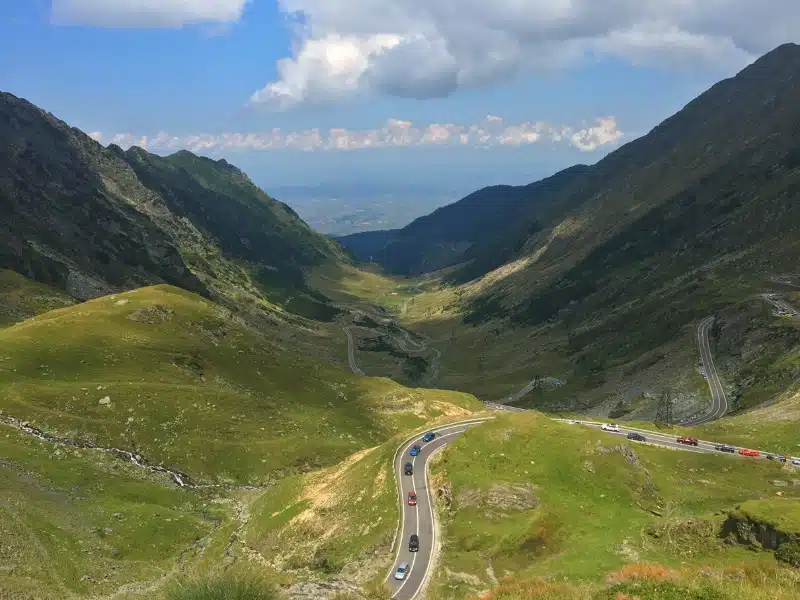
How long does it take to drive the Transfagarasan Road?
The Transfagarasan Road is 94 miles / 151 kilometers long and takes, according to Google Maps, just 3 to 4 hours to drive. But this is a simple equation of miles divided by speed and doesn’t take into account the topography of the road and its varying elevation, twists, bends, and sheep on the road, which all add to the driving time.
To truly enjoy the incredible scenery and the road itself, and have plenty of time to stop to explore and take photos, we recommend that you set off early and allow 5 to 6 hours to fully enjoy the Transfagarasan drive and experience.
Looking for the best SIM card deals in Europe for your trip? Check out our guide to the best data SIMs in Europe and get the best deal for your trip to Romania.
Is the Transfagarasan Road a dangerous road?
Although the route features on the dangerousroads.org website, the road itself is fully sealed and very well maintained, as you would expect in a European country.
The route features many steep hairpin turns and some dark and long tunnels but the Transfagarasan Highway speed limit is a mere 40km/h, meaning traffic travels slowly despite the supercars which can often be seen on the road.
There are large sections of non-barrier road with sheer drops of over 1000 feet / 305 meters, but the road is wide enough for cars to pass and there is no risk of the road giving way.
Where does the Transfagarasan Road start and finish?
The route, officially the DN7C starts near the village of Bascov, near Pitești, and ends at the crossroad between the DN1 and Sibiu.
In which direction should I drive the Transfagarasan Road?
The route from north to south is widely considered to have the better views. However, we think all the views are spectacular and if south to north is more convenient because of flying into Bucharest, you’ll still enjoy the same incredible experience.
Can I drive the Transfagarasan in a motorhome?
Yes, it is possible to take a motorhome, RV or overland truck along the Transfagarasan. Regular size tour coaches and even logging trucks use the road on a daily basis, so length is not an issue.
The tunnel and underpass dimensions range from 6 meters to 7.2 meters wide, and 3.9 meteres to 4.2 meters high.
You may encounter height restriction signs at tunnel entrances which read 3.6 meters. However, we know it’s possible to pass all the tunnels and underpasses in a vehicle up to 3.9 meters high.
Can I drive the Transfăgărășan & Transalpina in one day?
The less famous Transalpina Highway is also open between June and October and is another epic Romanian road.
Transalpina is a stunning destination for road trip enthusiasts. The highest paved road in Romania since 2009, the Transalpina reaches an altitude of 7,037 feet / 2,145 meters above sea level at the Urdele Pass.
The road spans 92 miles / 148km between Novaci in the south and Sebeș in the north as it winds its way through the majestic Parâng Mountains in the Southern Carpathians.
Both roads offer incredibly scenic drives, but if we had to pick one it would be the Transfăgărășan due to its history and variety of landscapes and attractions.
It is possible to do both of these incredible driving roads, although not in one day.
You’ll need two days to drive both these roads. Tackle Transalpina first, then head southeast to Sibiu on the E81 for an overnight stop. From there take the E68 to the crossroad with Transfăgărășan before heading south to Piteşti.
RELATED POST: Transalpina: All You Need to Know About Romania’s Highest Road
Where are the best places to stay on the Transfagarasan Road?
Hotel Subcarpati – Booking.com | Agoda
Hotel Posada – Booking.com | Agoda
Pensiunea Eden – Booking.com | Agoda
Hotel Posada Vidraru – Booking.com | Agoda
Cabana Zimbru – Booking.com | Agoda
In the winter, stay at the Ice Hotel, only accessible by cable car. In the summer, stay at Cabana Paltinu or Cabana Bâlea Lac.
Casa Mosului – Booking.com | Agoda
Pensiunea Bujor de Munte – Booking.com | Agoda
Romania Road Trip Resources
Here are the websites and services we personally use and recommend for traveling in Romania.
Tips for Driving in Romania
The roads in Romania can be a challenging drive due to their condition, which often includes potholes, roadside deterioration, and poor surfacing. Awareness of this is crucial to help you avoid damage to your vehicle and can slow down progress at times.
Whether you’re driving through Romania in your own vehicle or flying in and renting a car, you need to follow these rules when you drive and travel in Romania;
- You must have at least three months remaining on your passport (issued in the past ten years) at your intended date of departure from Romania.
- You may need a visa to enter Romania, you can find out more on the Romanian Ministry of Foreign Affairs website.
- You must have at least 3rd party insurance for your vehicle when you road trip in Romania.
- Citizens of non-EU third countries may require an International Driving Permit (IDP). You can check here.
- Motorists are also legally required to carry the following items when driving in Romania: reflective jackets for drivers and passengers; a warning triangle, a fire extinguisher, and a first aid box.
- Romania uses an electronic road tax system to collect tolls. The tax or vignette is payable at border crossing points, post offices, and online. It’s easiest to buy your Romanian vignette in this way, and our recommended website is authorized by the Romanian Government. You don’t need a sticker or device, just select your vehicle and the amount of time you need and pay online with Roviniete.ro. If you’re hiring, check whether a vignette is included with your car rental company.
- In Romania, motorists drive on the right and overtake on the left. As a general rule, priority must be given to vehicles coming from the right unless indicated
- The alcohol limit for drivers of private vehicles is 0.00%. Penalties for drink driving can be severe.
RELATED POST: Driving in Europe – Everything You Need to Know
Are you looking for more road trip inspiration? Check out these top posts…
European Road Trip: Six Countries in 90 Days
Norway Road Trip: Four Unmissable Routes
Germany Road Trip: 8 Unmissable Routes
The Perfect Andalucia Road Trip: 10-14 Day Itinerary
The Ultimate Bucket List Italy Road Trip
Spring Road Trip from Britain to Portugal
Love it? Pin it!
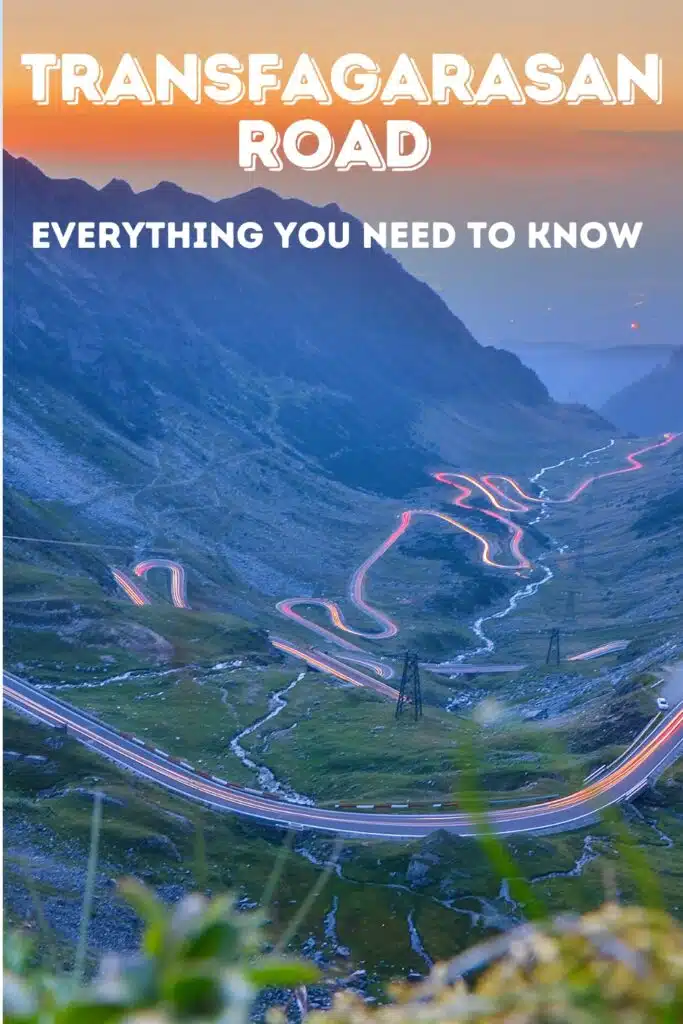
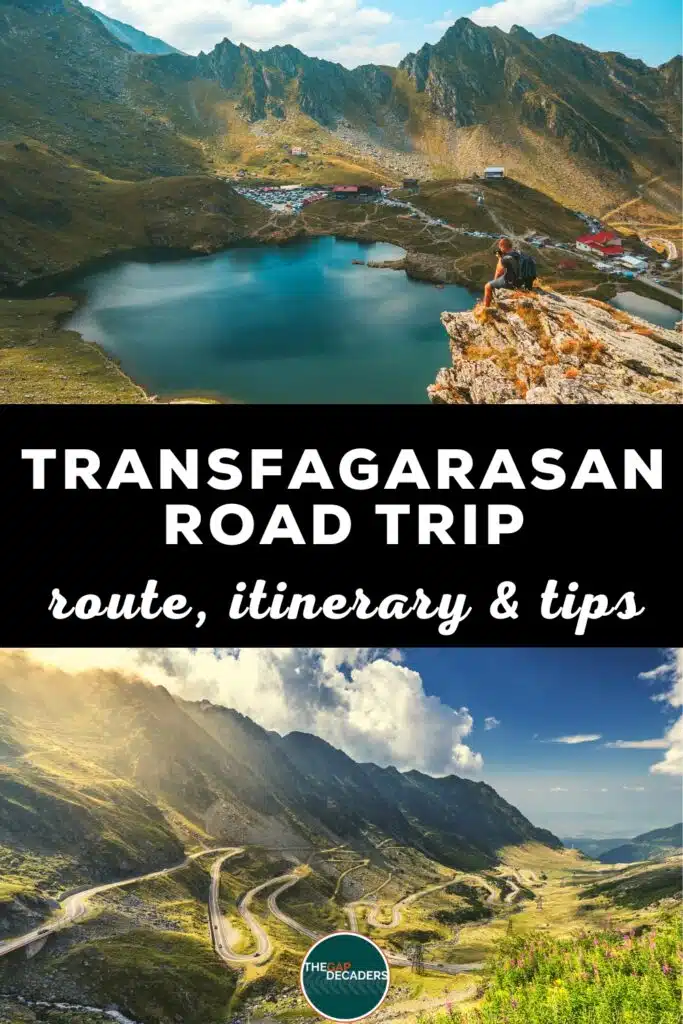

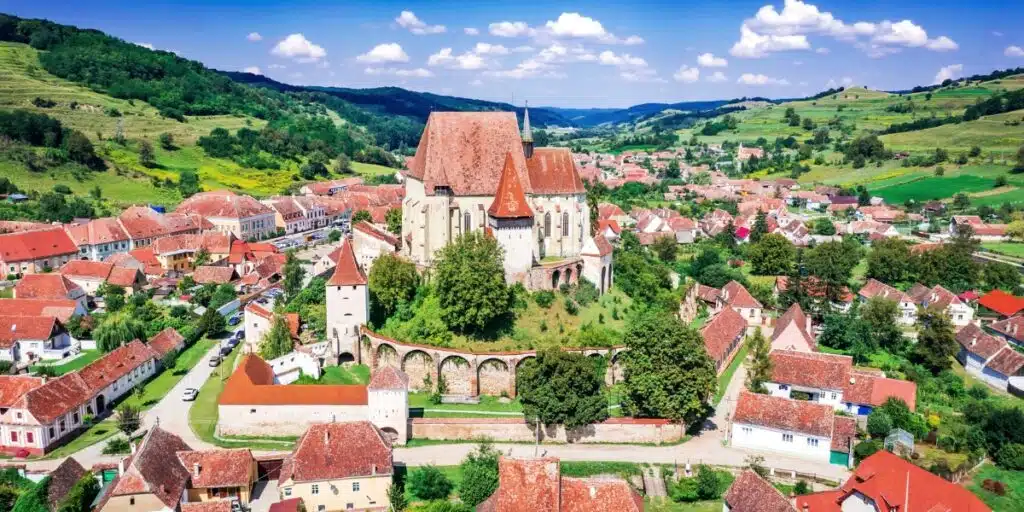

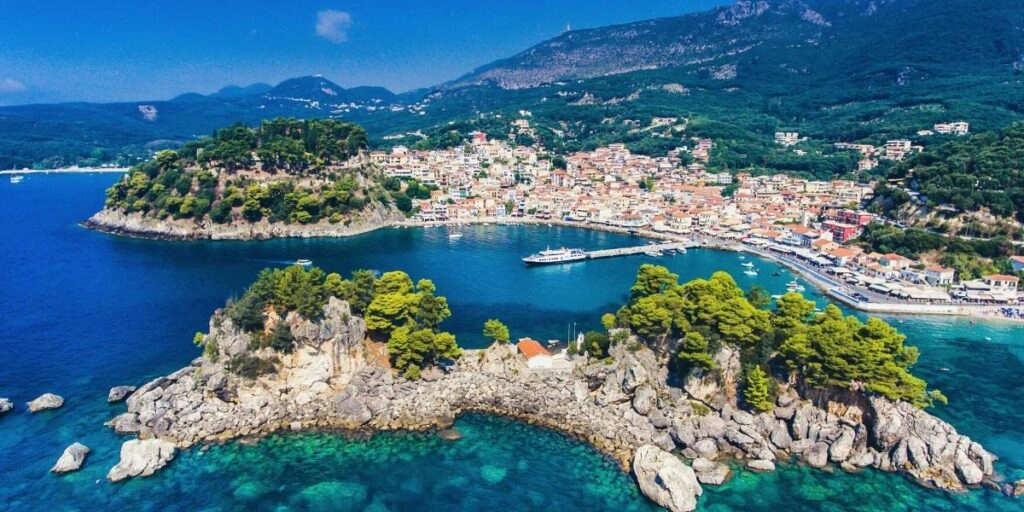
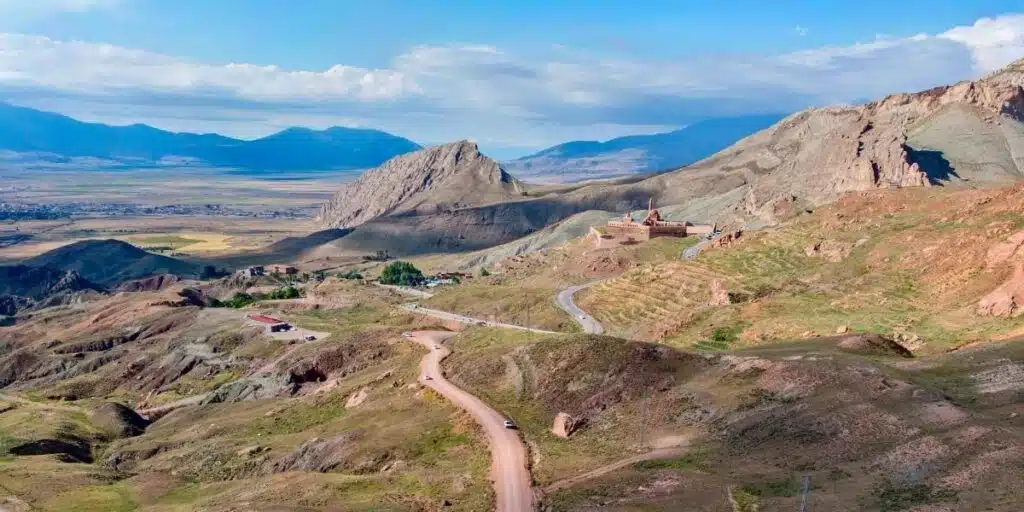
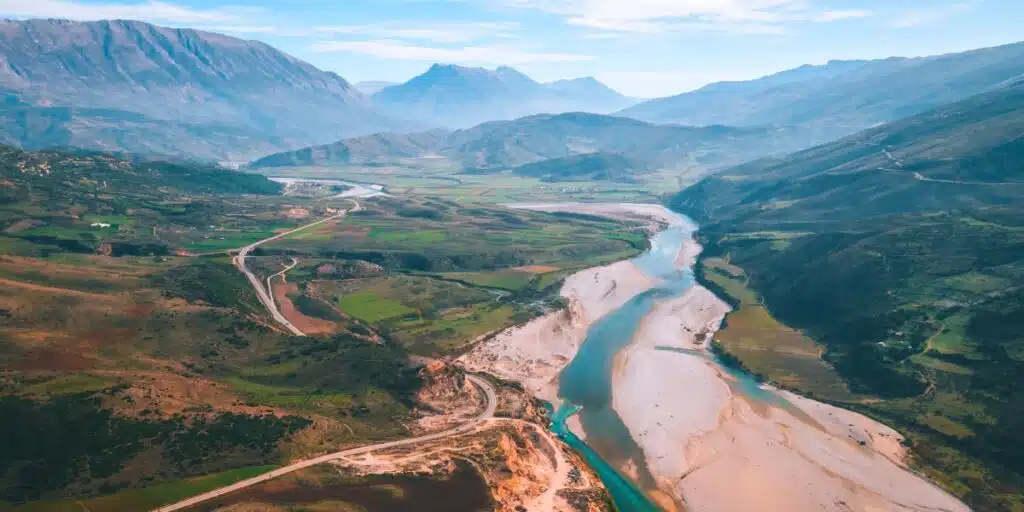
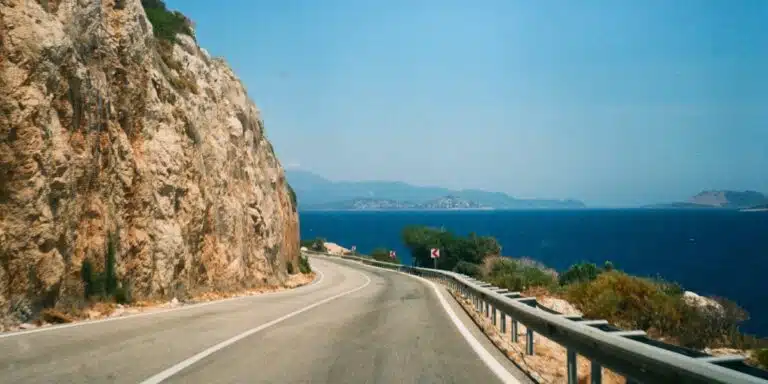

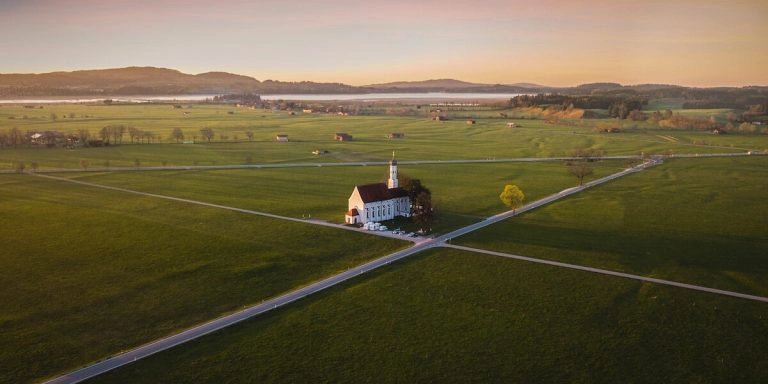
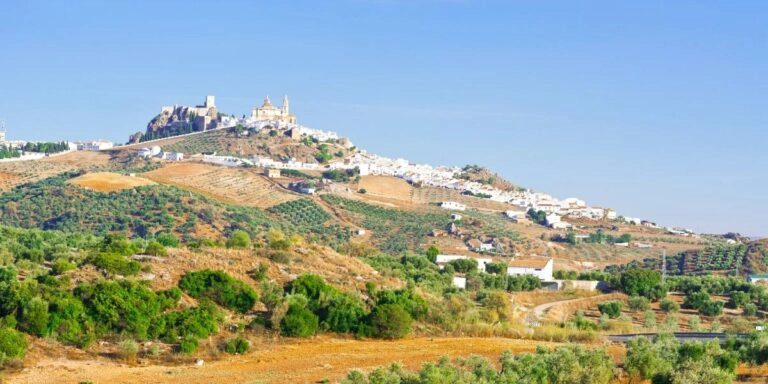
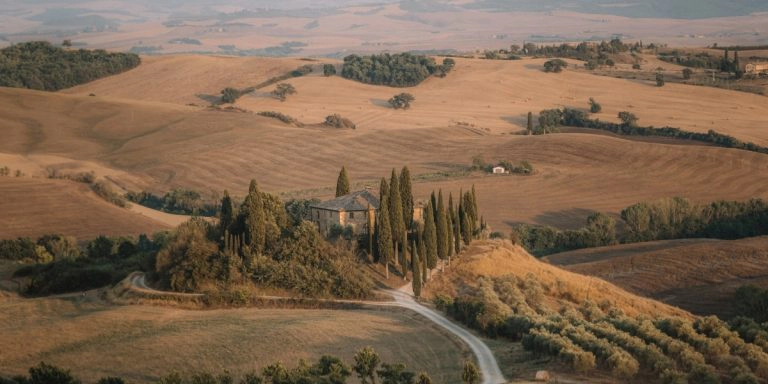
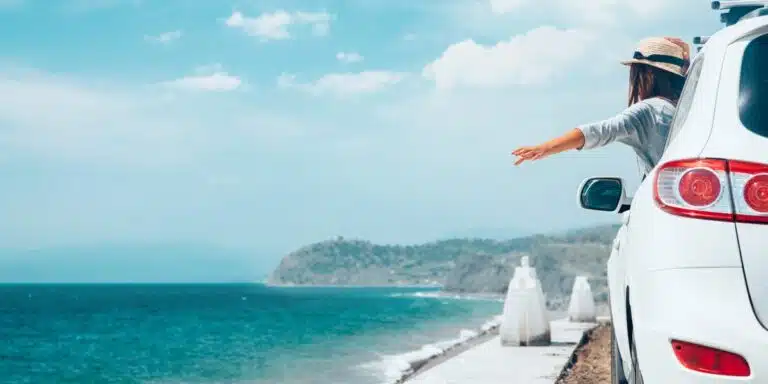
thank you for making this article very useful and keep up the good work
Thanks, glad you found it helpful 🙂
this article is very useful, thank you for making a good article